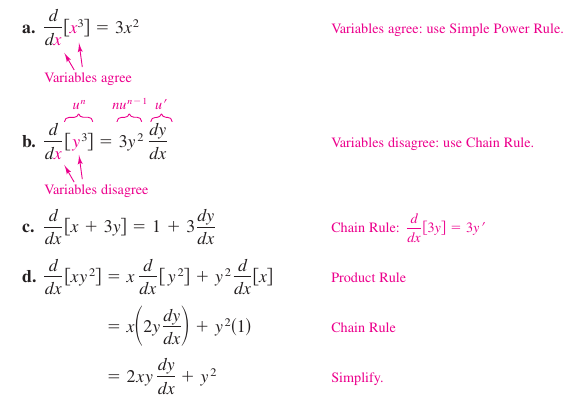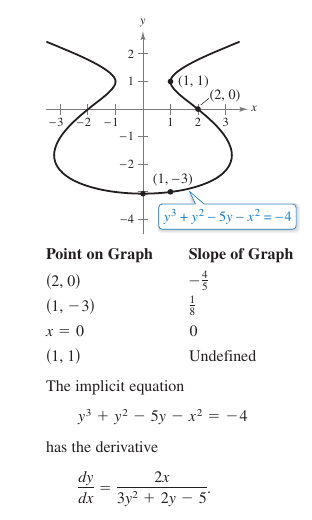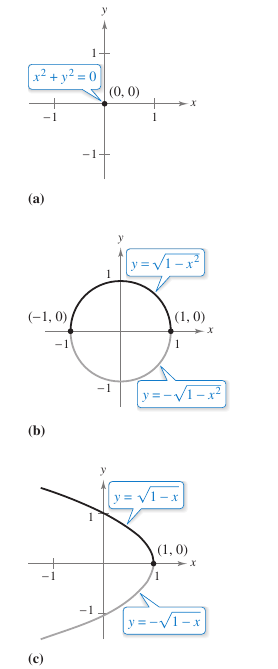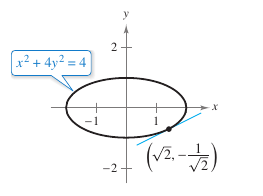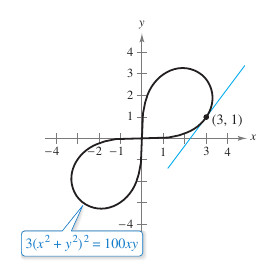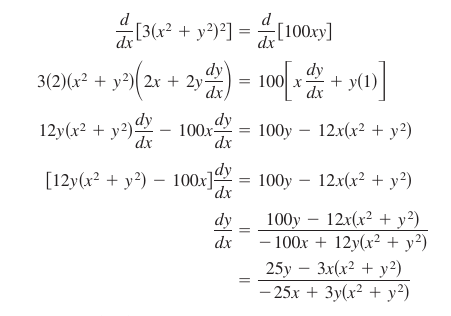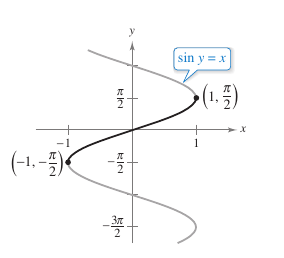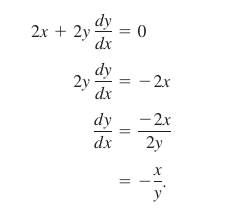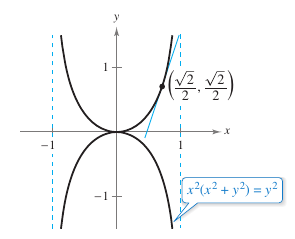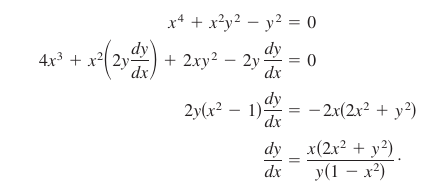Calculus I 02.05 Implicit Differentiation
| Previous | Calculus_I_02.04_The_Chain_Rule |
| Next | Calculus_I_02.06_Related_Rates |
Contents
- 1 Implicit Differentiation
- 1.1 Implicit and Explicit Functions
- 1.2 Implicit Differentiation
- 1.2.1 Example 2.5.2 Implicit Differentiation Guidelines
- 1.2.2 Example 2.5.3 Graphs and Differentiable Functions
- 1.2.3 Example 2.5.4 Implicitly Finding the Slope for a Graph
- 1.2.4 Example 2.5.5 Implicitly Finding the Slope for a Graph
- 1.2.5 Example 2.5.6 Determining a Differentiable Function
- 1.2.6 Example 2.5.7 Finding the Second Derivative Implicitly
- 1.2.7 Example 2.5.8 Finding a Tangent Line to a Graph
- 2 Internal Links
Implicit Differentiation
- Distinguish between functions written in implicit and explicit form.
- Use implicit differentiation to find the derivative.
Implicit and Explicit Functions
So far in the discussion functions were expressed in explicit form where \(y\) is equal to some function. For example, \(y=3x^2-5\) has the \(y\) variable explicitly written as a function for \(x\). With the implicit form the \(y\) variable is not isolated. For example, \(xy=1\) is a function where \(y\) is in the function. To find \(dy/dx\) for an implicit function rewrite it as an explicit function and differentiate.
| Implicit Form | Explicit Form | Derivative |
|---|---|---|
|
\(xy=1\) |
$$y=\frac{1}{x}=x^{-1}$$ |
$$\frac{dy}{dx}=-x^{-2}=-\frac{1}{x^2}$$ |
This strategy fails when \(y\) cannot be expressed as a function for \(x\). For example, how can
- $$x^2-2y^3+4xy=2$$
be differentiated? By using implicit differentiation.
Differentiation always takes place with respect to \(x\). When differentiating terms involving \(y\) the Chain Rule must be applied. The assumption is that \(y\) is defined implicitly as a differentiable function for \(x\).
Example 2.5.1 Differentiating with Respect to \(x\)
Implicit Differentiation
| Guidelines for Implicit Differentiation | |
|---|---|
| 1. | Differentiate both sides with respect to \(x\). |
| 2. | Move all terms involving \(dy/dx\) to the left and all other terms to the right. |
| 3. | Factor \(dy/dx\) from the left side. |
| 4. | Solve for \(dy/dx\). |
Example 2.5.2 Implicit Differentiation Guidelines
|
|
Find \(dy/dx\) given that
Solution
2. Collect the \(dy/dx\) terms on the left and move all other terms to the right.
3. Factor \(dy/dx\) out from the left side.
4. Solve for \(dy/dx\) by dividing by \((3y^2+2y-5)\).
Even when \(y\) is not a function for \(x\) the derivative produces a formula for the tangent line slope at several points, as shown in Figure 2.5.1. | ||||||||
|
|
Solving for \(dy/dx\) is meaningless in an equation with no solution points. For example, \(x^2+y^2=-4\) has no solution points. If a graph segment is represented by a differentiable function, then \(dy/dx\) will have meaning as the slope at each point on the segment. A function is not differentiable at points with vertical tangents and points where the function is not continuous. Example 2.5.3 Graphs and Differentiable FunctionsIf possible, represent \(y\) as a differentiable function for \(x\).
a. \(x^2+y^2=0\) b. \(x^2+y^2=1\) c. \(x+y^2=1\)
|
Example 2.5.4 Implicitly Finding the Slope for a Graph
|
|
Determine the tangent line's slope to the graph for
Solution
| ||||||||||||||||||
Example 2.5.5 Implicitly Finding the Slope for a Graph
|
|
Determine the slope to the graph for
at the point \((3,1)\), as shown in Figure 2.5.4. At the point \((3,1)\), the slope for the graph is
as shown in Figure 2.5.4. This graph is called a lemniscate graph. |
Example 2.5.6 Determining a Differentiable Function
|
|
Find \(dy/dx\) implicitly for the equation
Then find the largest interval for the form
Solution
The largest interval bout the origin for which \(y\) is a differentiable function for \(x\) is \(-\pi /2 < y < \pi/2\). Note that \(\cos y\) is positive for all \(y\) in this interval and is 0 at the endpoints. When restricting \(y\) to the interval \(-\pi/2 < y < \pi /2\) \(dy/dx\) can be written explicitly as a function for \(x\). Use the identity
and conclude that
|
Example 2.5.7 Finding the Second Derivative Implicitly
Given
- \(x^2+y^2=25,\)
find
- $$\frac{d^2y}{dx^2}.$$
Solution Differentiating each term with respect to \(x\) produces
Differentiating a second time with respect to \(x\) yields
|
$$=-\frac{(y)(1)-(x)(dy/dx)}{y^2}$$ |
Quotient Rule |
|
$$=-\frac{y-(x)( \color{red}{-x/y})}{y^2}$$ |
Substitute \(-x/y\) for \(dy/dx\). | |
|
$$=-\frac{y^2+x^2}{y^2}$$ |
Simplify. | |
|
$$=-\frac{\color{red}{25}}{y^3}.$$ |
Substitute 25 for \(x^2+y^2.\) |
Example 2.5.8 Finding a Tangent Line to a Graph
|
Find the tangent line to the graph for
at the point \((\sqrt{2}/2,\sqrt{2}/2)\), as shown in Figure 2.5.6. At the point \((\sqrt{2}/2,\sqrt{2}/2)\), the slope is
and the equation for the tangent line at this point is |
Internal Links
Parent Article: Calculus I 02 Differentiation
